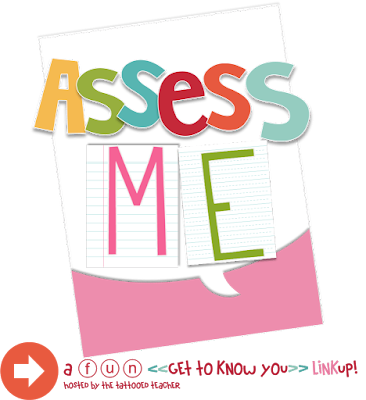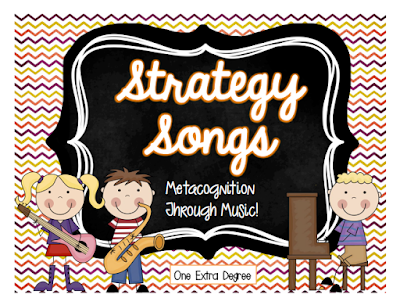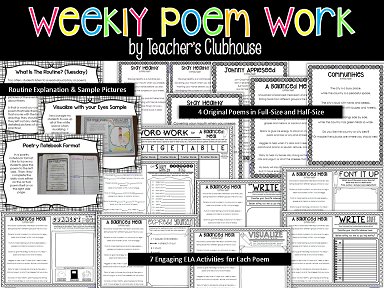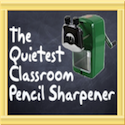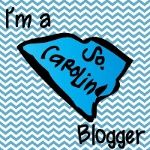Other Posts in This Series:
Before beginning my genre studies, I kick the year off with a Reading Strategies unit. I do this for several reasons. First, I want to provide a foundation for all of my students and make sure that they are doing what good readers should do as they read. Also, I don't know my students at the beginning of the year. I need to get to know them and their reading abilities a bit before I'm ready to start putting them in reading groups.
There are many reading strategies that we could focus on, but here are the ones I choose:
1) Making Connections
2) Inferring
3) Asking Questions
4) Visualizing
5) Synthesizing
6) Determining Importance
Most of my time is spent on the first four strategies, but we do hit the last two as well.
This is the book I originally used as a foundation for building my unit...
It's titled Reading Power by Adrienne Gear. It's a very easy read and has a wealth of information. I liked it because it gave ideas that were easy to implement with pretty much any picture books (though it did provide good suggestions). This allowed me to use books that I already had in my classroom!
This book has a song/chant for each strategy, lesson ideas, work samples, and lots of graphic organizers.
While the book was very valuable to me, it's not necessarily a necessity. You could absolutely create your own strategies unit without it!
I just received this book TODAY, which has been getting rave reviews from teachers, and can't wait to read it next week!
It's a little more expensive, but I've been told it's worth it! I'll let you know. :) The title is The Reading Strategies Book and it's by Jennifer Serravallo.
One of the things I love about my strategies unit is that it is ALWAYS evolving. Since strategies can be taught with pretty much any book, you are free to change things up quite a bit from year to year!
Let's take a little closer look at each strategy...
I usually begin with making connections. Let's face it - kids are pretty good at this! You know all of those times when you are reading a book and your students raise their hands to tell you a story? It's {usually} because they made a connection!!
However, most of the time they are making Text to Self connections {the text has made them think of something that has happened to them before}. We also explore Text to Text {when one book reminds you of another book in some way} and Text to World {when one book reminds you of something you've seen or heard about} connections. These are a little less automatic for students and they sometimes need encouragement to think of these.
Here are a few of the books I almost always include in my making connections lessons:
The Relatives Came by Cynthia Rylant
Alexander and the Terrible, Horrible, No Good, Very Bad Day by Judith Viorst
Oliver Button is a Sissy by Tomie DePaola
Amazing Grace by Mary Hoffman
But like I said, I'm always finding books I want to use on the fly and you can definitely find some to use from your current classroom selections.
While we practice this skill heavily during this time, it's a skill that will be used all year long and I keep that fresh in students' minds with our connection chains.
I keep these displays up all year and anytime a student makes a connection while I'm reading aloud a book, I have them add a link to the chain. They love to try to make more Text to World or Text to Text connections so that they don't get left behind! ;) It's a great visual to let them realize that they're constantly making connections and that Text to Self are the connections we make the most!
This activity, along with many others can be found in my
Connecting and Visualizing Packet. It's filled with many of the activities and assessments I use while working on these strategies.
That leads us to the other strategy in that pack - Visualizing.
Visualizing is one of my favorite strategies to teach! Students are used to drawing pictures about stories, but they're not used to drawing all of the little details. We work on that. :)
One of the first things we do with this strategy is talk about words. Some words help us to visualize and others do not. We do a lot of practice identifying these words and sorting words based on if they help us visualize or not. This is also when I introduce "prove it" (citing the text). I have students highlight words in text that help them visualize and when they illustrate the text, they should check back to make sure all of those highlighted words were included. Their illustrations become much more vivid!
A few books that I always love for this strategy include:
The Napping House by Audrey Wood
How I Became a Pirate by Melinda Long
Hush Little Polar Bear by Jeff Mack
That last book shows a cute cuddly polar bear and I just rant and rave about how much I love polar bears! I just want to snuggle up with him! I tell students this is my favorite animal ever - oh so cute! I ask them to all draw a picture of a polar bear for me to hang on my desk. They turn out so cute! Then, the next day I read a passage of text from a non-fiction book about polar bears. I choose the pages that portray the polar bear in quite the opposite image - as a predator, eating seals, hunting, with sharp claws. I pretend to be shocked and amazed at how my image of that cute, cuddly polar bear has suddenly changed based on this new information. It's quite a powerful lesson in teaching us that our visualizations {mind movies} or constantly changing as we read and acquire new information - at that's a good thing! I have students draw new polar bear pictures for me today - they're quite different. Lots of blood usually. :) The bad thing about this lesson is that I sell it too well. Almost every year my students bring me polar bear books from the library, polar bear information from the web, and even cute cuddly stuffed polar bears to sit on my desk. I really don't love them that much. Ha!
One of my favorite lessons for this strategy is to find a poem that sounds like one thing but really turns out to be something else! Students create a "Visualize with your Eyes" craftivity of themselves with sunglasses. As I read the first part of the poem, students record visualizing words around the glasses' rims and then illustrate in the first lens. Then, I'll finish the last part of the poem and they'll repeat with the second side. They love seeing how their image changed as new information was gathered!
After visualizing, we move on to Questioning.
This is another one students are already good at doing on a daily basis. :) However, we learn the importance of asking questions Before we read, During reading, and After we read. We also spend a lot of time on Thin and Thick Questions.
I define Thin Questions as those questions that students don't really have to use their brains to answer - the answer are "right there" in the book, or are readily known with short quick answers (think yes/no). Thick Questions are questions that students will have to use their brains to answer. There's often no right/wrong answer to these questions and others can often disagree.
Let me tell you that students LOVE being the teacher and creating questions (especially THICK ones) for their classmates to answer! :) We do a lot of partner teaching during this strategy - lots of practice!
My absolute FAVORITE activity during Questioning is to read a fairy tale (I usually pick
Snow White). Then, I have students write down two questions for characters from the story. I want them to ask THICK questions - things that the book didn't tell us, but if we had a chance to talk to the characters we could find out. Then, I tell them that the next day we'll hold a Fairy Tale Talk Show and the characters will come to our classroom for us to interview. They get SO excited. I'm not even kidding. I usually even get emails from parents about their students' anticipation to come to school the next day. :)
The next day, I will set up a row of chairs in front of the audience (the children) and then call some of them up to sit in the chairs. They soon realize that THEY are the characters - and I pull out props for them to wear....just to help them get into character a bit more. The audience asks their questions (example: "How did you get a magic mirror?" or "Why did you decide to let Snow White escape?") The characters have to think on their feet and
remember that there's no right/wrong answer. They have a ton of fun and we rotate characters in and out so everyone has experience asking and answering questions.
Some of my favorite books to use during Questioning are:
Grandfather Twilight by Barbara Berger
The Wednesday Surprise by Eve Bunting
Snow White {any version}
That activity and lots more can be found in my other
Reading Strategies unit: Questioning & Inferring.
Let's take a peek a Inferring.
It's so much fun to teach kids to make inferences! We learn to infer from pictures and from text - both are equally important! To begin with, we make inferences without books! We do a lot of charades where students act out feelings/emotions and others have to infer from the clues. Then, we move to wordless books...lots of inferring to be done there! We also use a lot of poems during this part. Many times you can remove the title or key words from a poem and let students infer what is happening in the poem or what it is about - so much fun!
Another fun activity is to infer from riddles. We do a lot of roam the room style activities with riddles that students must read and infer. It's a tougher skill for some students than I usually expect, but once we've nailed it we move on to inferring from text.
I created most of my inference riddles to integrate other subjects, too! As in these for community workers...
...and these about animals....
Some of my favorite books to use for making inferences are:
Today I Feel Silly: And Other Moods That Make My Day by Jamie Lee Curtis
Good Dog Carl by Alexandra Day
No, David! by David Shannon
I Want My Hat Back by Jon Klassen
Who Is The Beast? by Keith Baker
Tuesday by David Wiesner
I don't spend as much time on Synthesizing, but we do practice it. I haven't created any of my own resources for this strategy....yet, but you can find some super cute ideas {and FREEBIES} from Cara at
The First Grade Parade.
Some of my go-to books for this strategy include:
Miss Rumphius by Barbara Cooney
Gettin' Through Thursday by Melrose Cooper
Something Beautiful by Sharon Dennis Wyeth
Tight Times by Barbara Shook Hazen
I really need to create a unit for these last two! Determining importance is where I do two things - teach students to locate the main idea/message of a story and also the author's purpose. We always create these cute little PIEs from paper plates for helping us determine the author's purpose {Persuade, Inform, Entertain}.
All of these strategies will be the foundation for our reading this year. We will apply these strategies throughout all of our genre studies.
What does reading look like during this strategies unit? You will see me holding a mini-lesson at the beginning of our reading block. Usually this consists of me reading a book and teaching the strategy. Then, students will apply the strategy. Since I do not know them as readers by this point, usually they are not applying to their own books yet. However, sometimes they are! I have a little data on my students at this point (from end of 1st grade and STAR testing), so I can level them to some extent. For example, during the questioning unit, I will choose a book series that I have a ton of books on - like, "Little Critter" - those books range from 1.0 to 3.5 (using AR levels since STAR data is one that I have at this point). So I may pair students with another reader at their level and assign them a book to use for applying questioning. I love starting the the same series with such a range because everyone feels like they're on the same playing field. ;) And then we will come back for a quick wrap up at the end to share what we've learned from applying the strategy that day.
A couple other resources worth mentioning that I have in my bag of tricks for this opening unit are...
My brilliantly talented friend Amanda from
One Extra Degree has written her own songs for all of the strategies. They are amazing! But, the BEST part is that the file includes MP3's of her singing all of the songs!!!!! I can't tell you how much that helps THIS musically-challenged teacher! ;)
Also, I will be implementing my new
Poem Work each week this year. I've always loved implementing poems, but most of the packs I've found have been more geared toward K/1st. So, I'm creating my own this year and each week's poem has work that spirals most of these reading strategies! So excited about that!
I hope that gives you some ideas for kicking the year off with reading strategies. I can't wait to dive into the actual genre studies! I'll be back in a few days to tell you all about our Mysteries Study - including why I feel it's the perfect genre to get the ball rolling!




